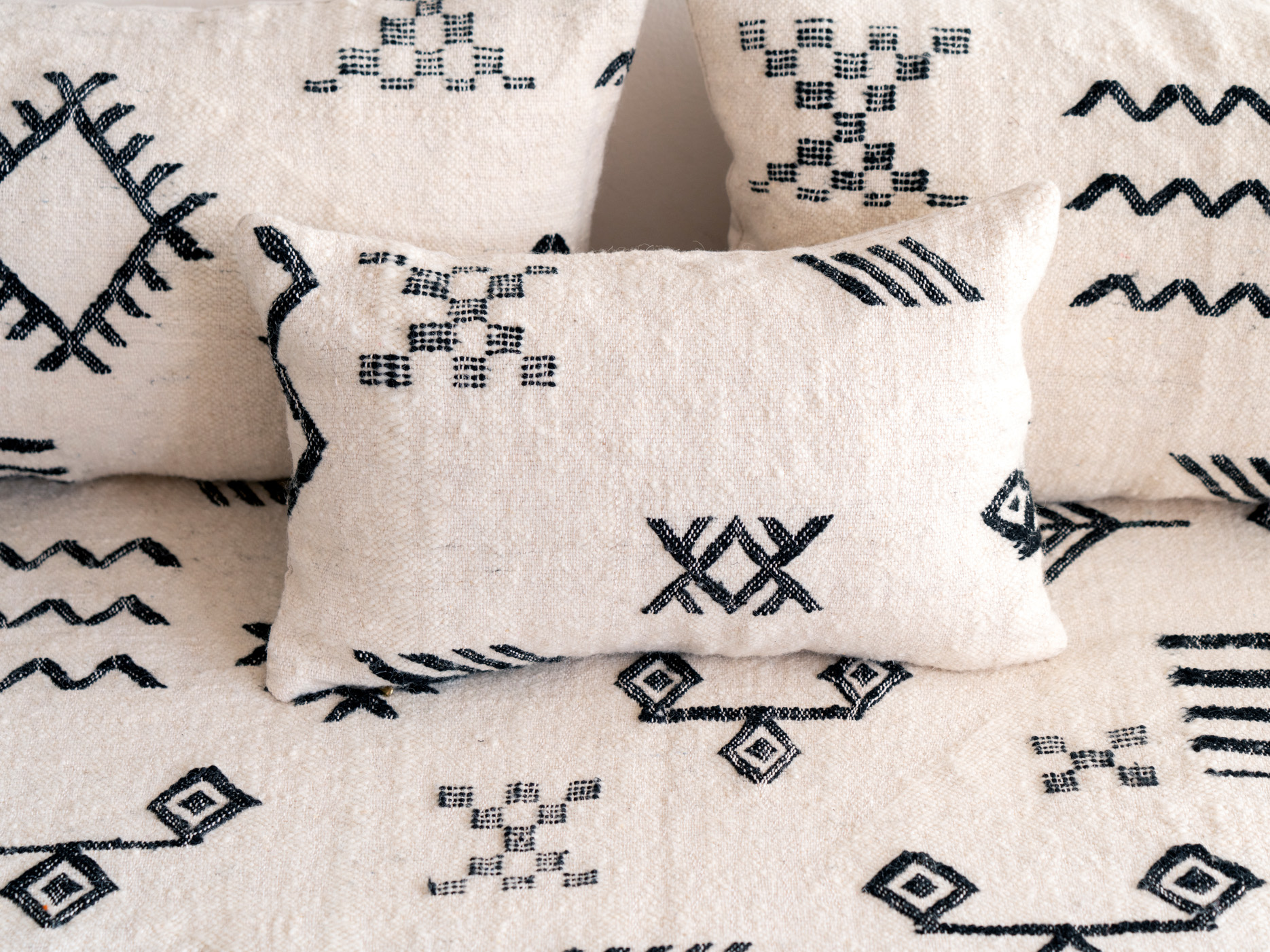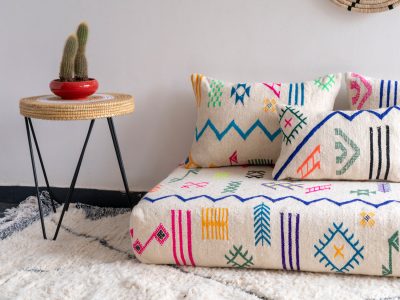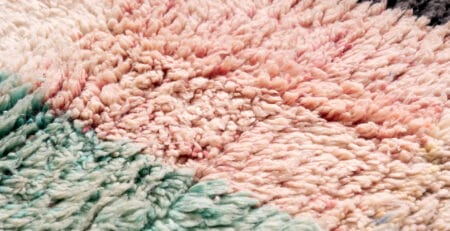Moroccan Patterns in Global Design Trends: From haute couture to home décor

In the world of design, Moroccan patterns have become a global sensation, influencing everything from haute couture to home décor. Known for their intricate geometric motifs and vibrant color palettes, Moroccan patterns are a testament to the rich artistic heritage of the country. From fashion runways to living room walls, these patterns have captured the imaginations of designers and consumers alike.
With its origins in Islamic art and architecture, Moroccan design has a timeless appeal that transcends borders. From New York to Tokyo, you’ll find Moroccan-inspired interiors, fashion collections, and textiles that add a touch of exotic elegance to any space. Whether it’s a traditional Berber rug or a modern interpretation of Moroccan tile work, these patterns bring a sense of warmth and sophistication to any setting.
From high-end fashion brands to mainstream retailers, the influence of Moroccan patterns can be seen across the industry. Their popularity is a testament to the enduring power of design and the universal appeal of cultural diversity. So next time you’re considering a design update, why not draw inspiration from the beautiful world of Moroccan patterns? It’s a surefire way to add a touch of global elegance to your space.
Table of Contents
History and Cultural Significance of Moroccan Patterns
Moroccan patterns are deeply rooted in the history and culture of Morocco, reflecting centuries of artistic expression influenced by various civilizations. The patterns primarily stem from Islamic art and architecture, which flourished in the region during the 8th century. This art form emphasizes geometric designs, intricate motifs, and a vivid color palette that are not just visually appealing but also carry profound cultural and spiritual meanings. The interplay of shapes and colors in these patterns often symbolizes the connection between the earthly and the divine, showcasing the craftsmanship and devotion of Moroccan artisans.
As Morocco has been a crossroads of cultures, the patterns have evolved, incorporating influences from Berber, Arab, and Spanish traditions. Berber artisans, for instance, have contributed to the rich tapestry of Moroccan design with their unique weaving techniques and symbols, often found in traditional rugs and textiles. The geometric patterns and motifs prevalent in Moroccan design serve as a narrative thread that connects the past with the present, offering a glimpse into the country's diverse heritage. Each design tells a story, whether it’s a homage to nature, spirituality, or the daily life of its people.
Moreover, the significance of Moroccan patterns extends beyond aesthetics; they represent a sense of identity and pride for the Moroccan people. In a globalized world, these patterns have become ambassadors of Moroccan culture, transcending geographical boundaries while retaining their cultural essence. As they continue to inspire designers and artists worldwide, the legacy of Moroccan patterns endures, reminding us of the importance of cultural diversity in the realm of design.
Moroccan Patterns in Interior Design and Home Décor
In the realm of interior design, Moroccan patterns have emerged as a popular choice for those seeking to create spaces that are both stylish and inviting. The intricate designs and vibrant colors associated with Moroccan aesthetics can transform any room, adding a touch of warmth and character. Whether it’s through decorative tiles, textiles, or furniture, Moroccan patterns offer a unique way to infuse a sense of global elegance into home décor.
One of the most iconic elements of Moroccan design is the use of zellige tiles, which are handcrafted and feature stunning geometric patterns. These tiles can be used to create striking backsplashes, accent walls, or even flooring, making them a versatile choice for various applications. The mesmerizing patterns not only serve as a focal point but also enhance the overall ambiance of a space. In addition to tiles, Moroccan textiles, such as rugs and cushions, add layers of texture and color, contributing to a warm and inviting atmosphere.
Furthermore, the incorporation of Moroccan patterns into interior design goes beyond mere decoration; it embodies a lifestyle. The essence of Moroccan living is reflected in the use of low seating, intricate lanterns, and rich textiles that encourage relaxation and social interaction. By embracing these elements, homeowners can create spaces that evoke the charm of Moroccan riads and courtyards, allowing them to escape the hustle and bustle of daily life. The timeless appeal of Moroccan patterns ensures their place in contemporary interior design, bridging the gap between tradition and modernity.
Moroccan Patterns in Fashion and Haute Couture
The influence of Moroccan patterns in fashion and haute couture is undeniable, as these designs have become a favorite among designers seeking to infuse their collections with exotic elegance. High-end fashion brands have embraced the rich heritage of Moroccan motifs, integrating them into garments that captivate audiences on international runways. Designers draw inspiration from the intricate tile work, vibrant colors, and geometric shapes that characterize Moroccan art, creating pieces that are both modern and timeless.
Notable fashion houses like Yves Saint Laurent and Dior have showcased collections featuring Moroccan patterns, highlighting their versatility and appeal. For instance, Yves Saint Laurent’s collection in the 1970s was heavily influenced by Moroccan aesthetics, reflecting the designer’s love for the country’s culture and landscape. The use of bold colors and dynamic patterns in these collections not only pays homage to Moroccan artistry but also brings a unique flair to contemporary fashion. As a result, Moroccan patterns have become synonymous with luxury, sophistication, and a sense of adventure.
Moreover, Moroccan patterns have found their way into everyday fashion, from mass-market brands to bespoke boutiques. They appear in various forms, such as printed dresses, handbags, and accessories, making them accessible to a broader audience. This democratization of Moroccan design has allowed people from different backgrounds to appreciate and incorporate these patterns into their wardrobes, fostering a sense of cultural appreciation. The fusion of traditional Moroccan designs with modern fashion sensibilities continues to create exciting opportunities for designers, ensuring that these patterns remain relevant in the ever-evolving fashion landscape.
Incorporating Moroccan Patterns in Accessories and Jewelry
Accessories and jewelry crafted with Moroccan patterns serve as captivating statements that celebrate cultural heritage while adding a unique flair to any outfit. The intricate designs found in Moroccan art can be translated into stunning pieces of jewelry, such as earrings, bracelets, and necklaces. Artisans often use traditional techniques to create intricate metalwork, incorporating geometric motifs and vibrant enamel colors that reflect the essence of Moroccan design.
In addition to jewelry, accessories such as handbags, scarves, and shoes featuring Moroccan patterns have become popular choices for fashion enthusiasts. These items allow individuals to express their personal style while celebrating the beauty of Moroccan artistry. A handbag adorned with intricate tile patterns or a scarf featuring bold colors can elevate a simple outfit, making it stand out in any setting. The versatility of these accessories makes them suitable for various occasions, whether it’s a casual outing or a formal event.
Moreover, incorporating Moroccan patterns into accessories and jewelry offers a way to connect with the rich cultural heritage of Morocco. Each piece tells a story, reflecting the craftsmanship and dedication of the artisans who create them. By choosing to wear these items, individuals not only embrace a unique aesthetic but also support the preservation of traditional craftsmanship. As Moroccan patterns continue to inspire designers worldwide, they remain an enduring symbol of cultural appreciation and artistic expression in the realm of fashion.
Popular Global Design Trends Inspired by Moroccan Patterns
The global design landscape has witnessed a resurgence of interest in Moroccan patterns, with numerous trends drawing inspiration from the country’s rich artistic heritage. One prominent trend is the fusion of traditional Moroccan motifs with contemporary design elements. This approach allows designers to reinterpret classic patterns, creating fresh and innovative pieces that resonate with modern aesthetics. The juxtaposition of bold colors and intricate designs with minimalist forms has proven to be a successful formula, appealing to a diverse range of consumers.
Another trend gaining traction is the emphasis on sustainability and ethical craftsmanship in the production of Moroccan-inspired products. As consumers become increasingly aware of the environmental impact of their choices, there is a growing demand for handmade items that reflect a commitment to sustainability. Artisans in Morocco often employ traditional techniques passed down through generations, ensuring that each piece is crafted with care and respect for the environment. This trend not only supports local economies but also promotes a deeper appreciation for the artistry behind Moroccan patterns.
Furthermore, the integration of Moroccan patterns into outdoor and garden design has become increasingly popular. The vibrant colors and intricate designs often associated with Moroccan aesthetics can create inviting outdoor spaces that reflect a sense of relaxation and comfort. From tiled patios to patterned outdoor cushions, these elements can transform gardens and terraces into enchanting retreats. The influence of Moroccan design in global trends serves as a reminder of the power of cultural exchange, showcasing how traditional motifs can inspire modern interpretations across various design disciplines.
How to Incorporate Moroccan Patterns in Your Home Décor
Incorporating Moroccan patterns into your home décor can be a rewarding endeavor, allowing you to create a space that exudes warmth and sophistication. One effective way to start is by introducing statement pieces that feature Moroccan motifs, such as a beautifully crafted rug or an intricately designed tile backsplash. These items can serve as focal points in a room, drawing the eye and setting the tone for the overall design. When selecting pieces, consider the color palette and style of your existing décor to ensure a harmonious blend.
Textiles are another excellent avenue for incorporating Moroccan patterns. Consider adding throw pillows, blankets, or curtains adorned with geometric designs and vibrant colors. These elements can soften a space and add layers of texture, making it feel cozier and more inviting. Additionally, incorporating Moroccan-inspired lanterns or light fixtures can create ambiance and enhance the overall aesthetic. The warm glow of lantern light adds a magical touch, reminiscent of traditional Moroccan riads.
Lastly, don’t be afraid to experiment with mixing and matching patterns. Moroccan design is inherently eclectic, allowing for a playful approach to combining different motifs and colors. By layering various patterns, such as pairing a bold rug with patterned cushions or incorporating artwork that features Moroccan designs, you can create a dynamic and visually interesting space. The key is to maintain a balance, ensuring that the patterns complement rather than overwhelm the overall design. Embracing Moroccan patterns in your home décor is not just about aesthetics; it’s about celebrating cultural richness and creating an environment that reflects your personal style.
Famous Designers and Brands Using Moroccan Patterns
Many renowned designers and brands have embraced Moroccan patterns, showcasing their beauty and versatility in various collections. One of the most notable figures is Pierre Yovanovitch, a French interior designer known for his ability to blend modern and traditional styles. His work often features Moroccan elements, such as intricate textiles and handcrafted furniture, creating spaces that are both luxurious and inviting. Yovanovitch’s designs exemplify how Moroccan patterns can be integrated into contemporary settings, offering a fresh perspective on traditional aesthetics.
Another prominent brand that has drawn inspiration from Moroccan design is Anthropologie. The retailer frequently incorporates Moroccan motifs into its home décor and fashion lines, celebrating the vibrant colors and intricate patterns that define this aesthetic. From patterned ceramics to textiles and furniture, Anthropologie’s collections reflect a love for global design and craftsmanship. Their commitment to sourcing unique and artisanal pieces allows customers to bring a touch of Moroccan charm into their homes.
Fashion designer John Galliano has also made a significant impact by infusing Moroccan patterns into his collections. Known for his theatrical and avant-garde approach, Galliano has drawn inspiration from Moroccan textiles and motifs to create stunning garments that challenge conventional fashion norms. His work highlights the adaptability of Moroccan patterns, demonstrating how they can be reinterpreted in innovative ways. The influence of these designers and brands not only showcases the allure of Moroccan design but also contributes to the ongoing conversation about cultural appreciation in contemporary fashion and design.
Where to Buy Moroccan Patterned Products
If you're looking to incorporate Moroccan patterns into your life, Asala Living is an excellent place to start. Specializing in authentic Moroccan furniture, sofas, and rugs, Asala Living offers a carefully curated selection that showcases traditional craftsmanship while adding a touch of global elegance to your space. Each piece reflects the beauty and cultural significance of Moroccan design, blending timeless patterns with high-quality materials. Beyond Asala Living, online marketplaces like Etsy also feature a treasure trove of handmade Moroccan items, including textiles, jewelry, and home décor. By supporting artisans directly, you can find unique pieces that celebrate the artistry of Moroccan craftsmanship, with many sellers even offering custom options to better suit your taste. Finally, design fairs and craft markets are a great way to discover Moroccan-patterned products. Events like Marrakech Design Week showcase the work of local artisans and designers, providing an opportunity to purchase items directly from the creators while fostering a deeper connection to the artistry behind Moroccan design.
By exploring these avenues, including Asala Living, you can enrich your home with stunning Moroccan furniture, rugs, and décor that bring timeless beauty and cultural charm to any space.
Asala Living: Moroccan Patterns, Woven Into Your Home
Conclusion: The Timeless Appeal of Moroccan Patterns in Global Design Trends
The enduring popularity of Moroccan patterns in global design trends speaks to their timeless appeal and cultural significance. From fashion runways to interior design, these intricate motifs have transcended geographical boundaries, captivating audiences with their vibrant colors and geometric designs. As designers continue to draw inspiration from Moroccan artistry, the patterns remain relevant, adapting to contemporary aesthetics while honoring their rich heritage.
Incorporating Moroccan patterns into various aspects of life—from home décor to accessories—offers individuals a unique opportunity to celebrate cultural diversity and artistic expression. The ability to mix traditional and modern elements allows for a personal touch that reflects individual style while embracing the beauty of global influences. As we navigate an increasingly interconnected world, the appreciation for Moroccan patterns serves as a reminder of the importance of cultural exchange and the power of design to bridge gaps between cultures.
Ultimately, Moroccan patterns are more than just decorative elements; they are a testament to the craftsmanship and creativity of artisans who have preserved their heritage for generations. As these designs continue to inspire and resonate with people around the world, they remind us of the beauty that lies in diversity and the stories that each pattern holds. Whether through fashion, home décor, or accessories, the allure of Moroccan patterns will undoubtedly continue to enchant and inspire for years to come.




Leave a Reply
You must be logged in to post a comment.